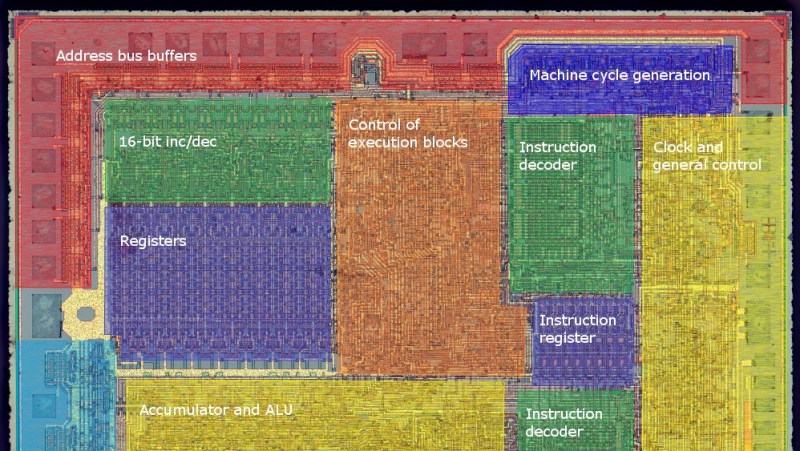The folks at Zeptobars are on a roll, sometimes looking deep inside historic chips and at others exposing fake devices for our benefit. Behind all of those amazing die shots are hundreds of hours of hard work. [Mikhail] from Zeptobars recently tipped us off on the phenomenal work done by engineer [Vslav] who spent over 1000 hours reverse engineering the Soviet KR580VM80A – one of the most popular micro-controllers of the era and a direct clone of the i8080.
But before [Vslav] could get down to creating the schematic and Verilog model, the chip needed to be de-capped and etched. As they etched down, they created a series of high resolution images of the die. At the end of that process, they were able to determine that the chip had exactly 4758 transistors (contrary to rumors of 6000 or 4500). With the images done, they were able to annotate the various parts of the die, create a Verilog model and the schematic. A tough compatibility test confirmed the veracity of their Verilog model. All of the source data is available via a (CC-BY-3.0) license from their website. If this looks interesting, do check out some of their work that we have featured earlier like comparing real and fake Nordic dies and amazing descriptions of how they figure out the workings of these decapped chips. If this is too deep for you check out the slightly simpler but equally awesome process of delayering PCBs.
















Imagine trying to build one of these with discrete components?
In 1964, Seymour Cray built the CDC 6600 with 400,000 transistors. So, been there, done that, don’t want to go back to that. Now, relays! That would be chill!
a computer that used relays would be a noisy SOB. limiting computers to places zoned commercial/industrial. Would be fun to put one in rural area close to a town, to see how long it takes someone yo instigate where the noise is coming from. Someone is boynd to hear it operating over night
RE relays and noise, do a search for how they used to connect phone calls before solid state switching. “phone”, “switch” and “room” would be good place to start. While not quite relays, they were electrically operated mechanical switches.
strowger!
http://www.youtube.com/watch?v=xUOh9fCSgqw
Exactly, I worked for some time with an ARF102 Ericsson analog teleephone switch. They were noisy (think of a constant fall of coins) but they made with relays memories, step counters and switching matrix ( search for CROSSBAR).
“Chill?” Wow. Autocorrect makes me sound a lot “chill”er than I actually am.
I understand doing stuff for kicks. I do have to wonder if we all turn our time just for kicks into something productive what the result. would be. Even if we converted just 25%.
I have done plenty of stuff for kicks, and the experience I gained helped a lot with productivity later.
Russian engineers, just as engineers do all over the globe, get RESOURCEFUL when they have limited resources. They get creative and do things in ways that you don’t think about when you have Intel to bankroll your thinking. Have you read the history of Chrysler? When they bought American Motors they tossed out their own engineers and replaced them with the AMC engineers because they were much more skilled at working with limited resources.
I really like that Zeptobar is color-coding the areas of the chip. I hope he continues this effort. Thank you!
Some may think that only the current generation has anything to teach us and that looking at the past is “just for kicks” but there is always a lot to be learned by going over inventions from the past. We take a lot of stuff for granted, that they had to work very hard to get. If you really think we have things figured out so well now, you should read “As We May Think” by Prof. Vannevar Bush. He had stuff figured out in the 1940s that Microsoft is STILL trying to get right. And REALLY I think if we were 25 % more productive we would just bring about the end of civilization that much faster. Maybe we need to be LESS productive and spend MORE time learning from the past, mother nature would probably appreciate it if you didn’t make one more thing to be thrown out.
Polish semiconductor company CEMI also made 8080 clone, MCY7880
http://www.elektroda.pl/rtvforum/viewtopic.php?p=12318564#12318564
Amazingly there is a TV program showing manufacturing process of this very CPU :o
http://www.youtube.com/watch?v=KHl6m93Hay0&feature=youtu.be&t=24s
From die shots and this program (showing different masks) it appears Polish version was almost a straight copy of the Intel, with small modifications (different feature sizes, additional debug pads).
almost forgot – yields were terrible, not surprising when you watch this clip and see chemical baths done manually by flipping wafers in liquids like fries at a fast food restaurant :) Despite all this Elwro,
Polish calculator manufacturer, designed accounting system based on MCY7880 (Elwro 500/513/523), with 8-512KB ram, two 8 inch floppies, printer and a monitor made out of modified 12 inch _camping TV_ (Neptun 150) :))), all running CP/M 2.2 (pirated and translated to Polish).
http://translate.google.com/translate?hl=en&sl=pl&u=http://www.elwrowcy.republika.pl/strona65.html
Popularity of this computer system forced CEMI to import KR580VM80A from USSR, and encapsulate them with CEMI logo (to save face I guess). Few people decapped MCY7880, and you mostly find russian dies inside.
Go Vslav!
I know this is an old post and no one will ever read this but I still find the “clone” part confusing.
They just now reverse engineered it, but, this is a clone! They apparently knew enough about the 8080 to re-create it back then!
I’m guessing the process to “clone” a processor is like an emulator, you have a certain output you’re trying to match, and you change things until the output matches, but it’s not a reverse-engineered 1-to-1 match.
If anyone ever reads this please let me know if I’m off base.